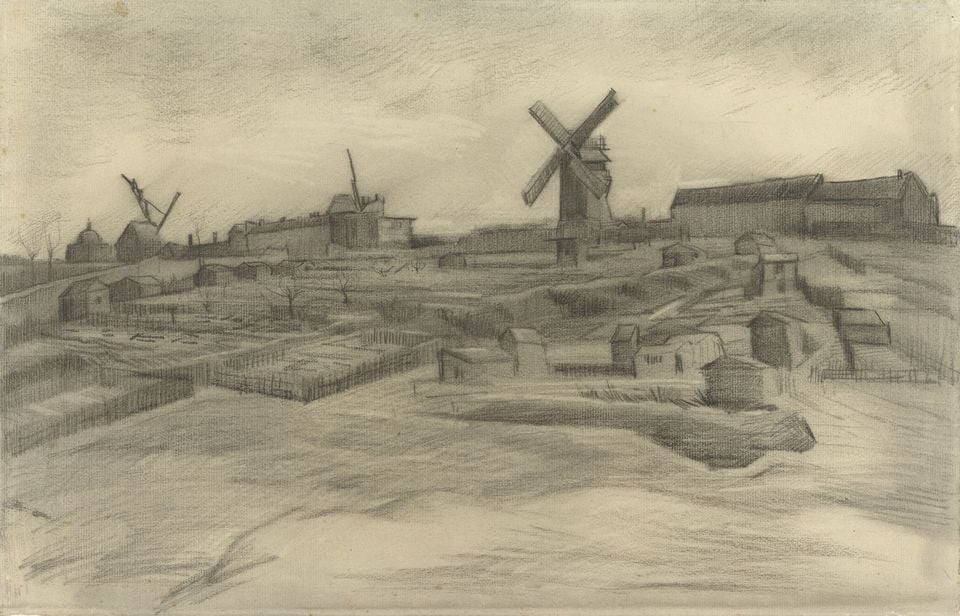Newly Identified Vincent van Gogh Drawings Go on Display
The two works were drawn during the artist’s formative years in Paris
:focal(484x182:485x183)/https://tf-cmsv2-smithsonianmag-media.s3.amazonaws.com/filer/b4/8b/b48b8bf7-d0cf-4e5e-bb9f-1bfa2c5eafcc/vincent_van_gogh_de_heuvel_van_montmartre_met_steengroeve_maart_1886_van_vlissingen_art_foundation-1.jpg)
In early 1886, Vincent van Gogh moved from Brussels to Paris, where he lived for two years with his brother Theo. Their apartment was located just a few minutes from Montmartre, the famous hill in the city’s 18th arrondissement. Now, as Martin Bailey reports for the Art Newspaper, a previously unknown sketch of the famed Parisian landmark has been confirmed as one of van Gogh’s drawings.
Titled "The Hill of Montmartre with Stone Quarry," the work is a dusky sketch that shows a cluster of buildings and windmills on the top of Montmartre, with a quarry further down the hill. In 2014, the drawing was acquired by the Netherlands’ Van Vlissingen Art Foundation, which then collaborated with the Van Gogh Museum in Amsterdam to confirm its authenticity. Researchers examined the work’s subject, style and technique, along with documentary evidence, before concluding that it was indeed drawn by van Gogh.
The drawing was previously owned by an American collector, whose Dutch relatives had purchased it in 1917, reports Nina Siegal of the New York Times. Up until 1911, the work had been held by van Gogh’s sister-in-law, Johanna van Gogh-Bonger, who carefully cared for the artist's collection after his death. She had numbered the drawing 123 in her inventory; Teio Meedendorp, a senior researcher at the Van Gogh Museum, tells Siegal that when he removed the newly discovered sketch from its frame, he found the number 123 etched on the back.

The authentication of "The Hill of Montmartre with Stone Quarry" soon led to revelations about a similar drawing, titled “The Hill of Montmartre.” This piece had been included in two catalogues raisonnés, or complete listings, of van Gogh’s work in the 1970s, but was removed from the museum’s own catalogue in 2001 due to doubts about its origins. According to Bailey, curators decided that the drawing’s “cautious, dutiful draughtsmanship” was inconsistent with the vibrant intensity of van Gogh’s better-known works. When experts viewed the two drawings side-by-side, however, they were forced to reconsider.
“It’s the same materials, the same paper, it’s quite clear that these were both done by the same hand at almost the same time,” Meedendorp tells Siegal. “If this was a van Gogh drawing then the other one had to be one was well.”
The drawings date to 1886, the beginning of van Gogh’s formative years in Paris. While living in the city, he met many architects of Impressionism—among them Henri de Toulouse-Lautrec, Camille Pissarro, Georges Seurat and Paul Gauguin—and took in their bold, radical approach painting. Van Gogh began to move away from the more staid works of his early career, developing a unique style marked by dynamic brushstrokes and dramatic colors.
In the two new drawings, one can see the artist begin to shift towards the more experimental style of the Impressionists; the works form a “kind of stylistic missing link between his Belgium and Paris time,” Meedendorp tells Siegal.
Both drawings can now be seen at the Singer Laren museum in the Netherlands, where are being displayed at an exhibition titled “Impressionism & Beyond.”